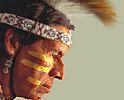| Native American Home |Members Page |InfoWizzard |Articles Site Map |Archives |What's New |Top 100 |Events |Mail Bag |Online Catalog | ||
 |
 |
 |
| Neshnabek - Keepers of the Sacred Fire |
      |
|
Bookmark Us
Subscribe Newsletter Post your Potawatomi articles here | |
|
Potawatomi Statistics and Addresses Potawatomi statistics overview and contact information for Potowatomi indian tribes.Potawatomi Statistics:Potowatami indians today are divided into seven distinct bands in the United States and three bands in Canada. They are a Woodland Indian tribe. The Potowatami language belongs to the Algonquin language stock. In their own language, the potowatami people call themselves Neshnabek, a Potawatomi word that refers to "original people".Estimates of the original Potawatomi population range as high as 15,000, but 8,000 is probably closer to the truth. Although they had undergone 30 years of war, relocation, and epidemic, the French estimated there were about 4,000 in 1667. Since all Potawatomi bands had gathered into four villages near Green Bay at that time, this probably was fairly accurate. Later estimates vary between 1,200 to 3,400, but the Potawatomi had separated into many bands, and these estimates failed to list all of them. Accurate counts were not possible until the Potawatomi had been moved to Kansas. In 1854 the Indian Bureau listed 3,440 on the reservation, but some had left with the Kickapoo for northern Mexico. The report also mentioned 600 "strolling Potawatomi," who had avoided removal and were somewhere in Michigan, Indiana, and Wisconsin. It also failed to include the 400-600 Potawatomi in Canada. The 1910 census listed 2,440 Potawatomi in the United States, with another 180 in Canada - total of 2,620. The current population of all Potawatomi in Canada and the United States is almost 28,000. The Potawatomi people are located in Oklahoma, in southwestern and northern Michigan and northern Indiana, northern Wisconsin and northeastern Kansas in the United States and in southern Ontario and on the Walpole Island Reserve in Canada. Potawatomi Addresses:United States Potawatomi TribesCitizen Potawatomi Nation1601 S. Gordon Cooper Dr. Shawnee, OK 74801 Official Website: Citizen Potawatomi Nation Population: Headquartered in Shawnee, they are organized under the Oklahoma Indian Welfare Act with a current enrollment of more than 18,000. History: Federally recognized, the Citizen Potawatomi are the largest Potawatomi group. Most are descended from the Potawatomi of the Woods (southern Michigan and northern Indiana) including the Mission Band from St. Joseph in southwest Michigan. Acculturated and mostly Christian, it was easier for them to accept allotment and citizenship in 1861 than the more traditional Prairie Potawatomi. This led to a separation (not on the best of terms) in 1870 when the Citizens moved to Oklahoma. Allotment took most of their land in 1889, and they have kept only 4,371 acres, less than two acres of which is tribally owned! Most Citizen Potawatomi have remained in Oklahoma - the Indian Bureau listing 1,768 of them in 1908 - but during the dust bowl of the 1930s, many left for California. Forest County Potawatomi Community P. O. Box 340 Crandon, WI 54520 Phone Toll Free: 800-960-5479 Official Website: Forest County Potawatomi Community Population: Federally recognized with an enrollment close to 800, they live in three separate communities with the tribal headquarters in Crandon, Wisconsin. History: Probably the most traditional group, the Forest County Potawatomi of northern Wisconsin have retained much of their original language, religion, and culture. They are descended from three Potawatomi bands from Lake Geneva in southern Wisconsin who avoided removal by moving north to the Black River and Wisconsin Rapids. In 1867 they were joined by Potawatomi who had left Kansas. In 1913 the government accepted their residence in Wisconsin and purchased 12,000 acres for them. Since the original intention was to distribute this in individual allotments, the parcels were scattered, but resistance to individual ownership delayed this until they had re-organized under the 1934 Indian Reorganization Act. All land, except for 200 acres, is tribally owned. Hannahville Indian Community N 14911 Hannahville B-1 Rd. Wilson, MI 49896-9728 Phone: 906-466-2932 Official Website: Hannahville Indian Community Population: Federally recognized since 1936, membership is almost 900. History: The Hannaville Potawatomi at Wilson in upper Michigan share a similar history with their Forest County counterparts. Originally from Illinois and Wisconsin, they refused to leave after 1834 and moved to northern Wisconsin. For a time, some lived with the Menominee while others stayed with the Ojibwe and Ottawa in Canada. Some returned to the United States in 1853 but were landless. Peter Marksnian, an Ojibwe missionary, found some land for them in 1883, and Hannaville was named after his wife. Congress in 1913 acknowledged the Hannaville Potawatomi and purchased 3,400 acres of scattered parcels - 39 acres were added in 1942. Nottawaseppi Huron Band of Potawatomi Indians Huron Potawatomi, Inc. 2221 - 1-1/2 Mile Rd. Fulton, MI 49052 Phone: 269-729-5151 Official Website: Nottawaseppi Huron Band of Potawatomi Indians Population: Approximately 600. History: Originally a part of the Detroit Tribes in southeastern Michigan, the Huron Potawatomi did not entirely escape removal. Gathered by soldiers and sent to Kansas in 1840, the bands of Mogwago and Pamptopee escaped and returned to Michigan. The government relented in 1845 when President Polk signed a bill giving 40 acres of public lands in southeast Michigan to the Huron Potawatomi. Another 80 acres was added to this in 1848, with a Methodist mission established the following year. Most Huron Potawatomi became citizens and took their lands in severalty during 1888, and federal tribal status was officially terminated during 1902. However, the Nottawaseppi continued their tribal organization and traditions, andthey were successful in regaining their federal recognition late in 1995. Match-E-Be-Nash-She-Wish Band of Potawatomi (Gun Lake Tribe) P.O. Box 218 Dorr, MI 49323 Phone: 616-681-8830 Phone Administrator::(616) 681-9510 ext. 343 Toll Free: (866) 681-9510 Fax: (616) 681-9520 Email: ddkrauss@mbpi.org, Tribal Administrator Official Website: Match-E-Be-Nash-She-Wish Band of Potawatomi (Gun Lake Tribe) Population:??? History:??? Pokagon Band Potawatomi Indians 104 N. Riverside Drive Dowagiac, MI 49047 Phone Toll Free: 888-376-9988 Official Website: Pokagon Band Potawatomi Indians Population: Currently, most of their 2,600 members are scattered among the general populations of southern Michigan and northern Indiana. History: Roman Catholic and acculturated because of the St. Joseph mission, the Pokagon were protected from removal by treaty and were allowed to stay in southwest Michigan. Their name derives from Chief Simon Pokagon, a famous Native American lecturer during the 1850s. Refused tribal status under the Indian Reorganization Act (1934), their long struggle to gain federal recognition finally succeeded in 1994. With tribal offices located in Dowagiac, Michigan, the Pokagon are in the process of reacquiring a land base. Prairie Band Potawatomi Nation 14880 K Rd. Mayetta, KS 66509 Phone: 785-966-4007 Official Website: Prairie Band Potawatomi Nation Population: Population in 1908 was only 676, but since then, it has grown to almost 4,000 with the tribal headquarters in Mayetta, Kansas. History: Formed from the Forest and Prairie Potawatomi bands west of Lake Michigan, they were removed to southwest Iowa in 1834. They were accompanied by Ottawa and Ojibwe from the same area who merged with them. Placed on a Kansas reservation in 1846 with the Potawatomi of the Woods and Mission Band, the Prairie Potawatomi preferred to hold their land in common and remained in Kansas when the Citizens left for Oklahoma in 1870. They were eventually forced to accept allotment which reduced their land from 77,400 acres to the current 20,325 - 560 tribally owned. The Prairie Potawatomi are usually traditional, and many practice either the Drum Religion or belong to the Native American Church. Potawatomi Nations in CanadaWhen removal to Kansas and Iowa began in the 1830s, some Potawatomi escaped by moving to Canada. Those from Indiana and lower Michigan slipped into southern Ontario, where they settled among the Ojibwe and Ottawa at Walpole Island, Stoney Point, Kettle Point, Caradoc, and Riviere aux Sables. At the same time, other groups of Potawatomi west of Lake Michigan crossed near Sault Ste. Marie to the Ojibwe and Ottawa communities on Cockburn and Manitoulin Islands. After the "heat was off," some of the northern groups returned to the United States and became the Hannaville Potawatomi.The Canadian Potawatomi over the years have intermarried with the Ojibwe and Ottawa blurring tribal identity. At present, more than 2,000 Native Americans in Canada can claim Potawatomi descent.Walpole Island First Nation R. R. #3 Wallaceburg, Ontario N8A 4K9 Phone: 519-627-1481 Official Website: Walpole Island First Nation Population: ??? Council Affiliation: ??? Band Chief: ??? Community Facilitator: ??? History: Walpole Island has never been founded, legislationed, established, set apart or surveyed officially as a "reserve," but is often referred to that way. Walpole Island has the distinction of being "unceded territory" and the Southernmost First Nation "reserve" in Canada. It consists of six islands with Walpole being the largest, with a total land base of 58,000 acres. Although the Pottawatomi settled permanently at Walpole Island only after 1836, they had used the territory of southwestern Ontario at a much earlier date. When removal to Kansas and Iowa began in the 1830s, some Potawatomi escaped by moving to Canada. Those from Indiana and lower Michigan slipped into southern Ontario, where they settled among the Ojibwe and Ottawa at Walpole Island, Stoney Point, Kettle Point, Caradoc, and Riviere aux Sables. At the same time, other groups of Potawatomi west of Lake Michigan crossed near Sault Ste. Marie to the Ojibwe and Ottawa communities on Cockburn and Manitoulin Islands. After the "heat was off," some of the northern groups returned to the United States and became the Hannaville Potawatomi. Wasauksing First Nation (Parry Island) P.O. Box 250 Parry Sound, Ontario P2A 2X4 Phone: 705-746-2531 Official Website: ??? Population: 956 Council Affiliation: None Band Chief: Wilfred King Community Facilitator: Doreen Trudeau History: The Wasauksing First Nation are descendants of a larger Band known as the Southeastern Ojibway, who occupied the eastern shore of Georgian Bay, the north shore of Lake Huron and part of the northeast shore of Lake Superior. The Parry Island reserve is within the boundaries of the territory described in the Robinson-Huron Treaty of 1850. Two years after the treaty, the Band's request to have the reserve on Parry Island, instead of on the mainland as originally planned, was granted. Chippewas of Kettle and Stony Point First Nation (Kettle Point No. 44) RR #2 Forest, Ontario, Canada, N0N 1J0 Phone: (519)786-2125 Official Website: ??? Population: ??? Council Affiliation: ??? Band Chief: ??? Community Facilitator: ??? History: ??? Add to this resouce by posting your potawatomi articles or corrections here. If you are suggesting a correction, please give the URL of the page the error is on. Michigan Indian Nations with Federal or State recognition Tribes from the Algonquin language group Potawatomi Tracks: The Ballad of Viet Nam and other stories What is the meaning of the word kemosabe or Kemo Sabe? Where Did Michigan's First People Live? General cultural beliefs of Algonquin speaking tribes Who were the Algonquin and who are they now ? Indian tribes that lived in Michigan History of the Anishinabeg (Ojibwe) people Indigenous Languages Spoken in the United States Algonquian is a language group, not a tribe of Indians Kansas Indians Oklahoma Indian Tribes Michigan Indians Indiana Indians Ontario First Nations RELATED TRIBES AND AFFILIATIONS: Algonquian Language Family Tree Woodland Indian Tribes Tribes of the Three Council Fires Ottawa Indians (Odawa) Chippewa Indians (Ojibwa, Ojibwe, |
OUR SPONSORS: If you sign up from the above link, drop us an email and we'll give you some tips to help you get started making money FAST with targeted ads. This sponsor pays our rent every month.  Webmasters Make $$$ We make the car payment and pay the utilities with this affiliate program. Sign up from the link above, then shoot us an email with your member name and we'll be glad to give you some pointers that will really make a difference in your bottom line. This program allows you to choose to advertise a wide range of products, so you can find ads that are a great fit with your site content, which really increases sales. When you sell something, they pay you a commission. We earn our entire income from the three programs above, and were able to quit our day jobs. Give it a try! | |||||||||||||||||||||||||||||||||||||||||||||||||||